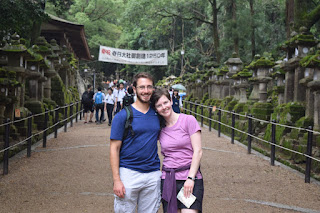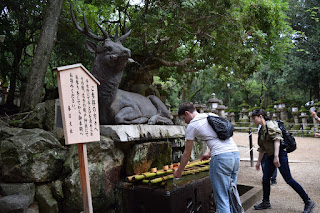Japan Day 7- Nara
The weather forecast for Sunday was for fairly heavy rain in Kyoto (shocking I know), but when we checked the radar we saw that the area around Nara seemed like it might be clear, so we made a decision that morning to give it a go. Nara is a small city about an hour's train ride from Kyoto, known for its temples, shrines, and most importantly, deer. The deer is thought to be sacred in Shinto culture, and Nara has become something of a deer sanctuary over the years. Now the deer are everywhere - in the streets, in the park, and you can buy crackers for them to eat out of your hand as they are quite used to people.


When we first arrived in the city we wandered through a large-ish temple complex on our way to the most well known temple, the Todaiji. The first complex had a number of cool buildings, including the 2nd tallest pagoda in Japan, standing 50m tall! Given this was such a nice round number, we took to describing our walking distances for the next few days in terms of the number of pagodas (or pagodim, if you will) away something was. In the complex we had a nice chat with a volunteer guide, who explained the buildings to us, and made a great show of how many times each of them had burned down over their lifetimes. You'd think this would deter the whole giant wooden structure thing (especially the pagodas with big metal spires on top - this one had burned down seven times!), but apparently not since they just kept on getting rebuilt time after time.
Of course, we had to buy some deer crackers to feed the deer while we were there and, thanks to previous experience, we took them a little ways away from the main crowd of deer into a meadow with just a few. They were still quite interested though, let me tell you. Charlie and Cackett had a great game of "pass the cracker" going with the last cracker as well, which was hilarious to watch.
From the park, we walked up the main road to the Todaiji - a Buddhist temple hall that was the largest wooden structure in the world until 1998. You start to get a feel for the scale of the place just walking through the enormous southern gate of the temple complex.
The great hall itself houses a huge bronze Buddha statue, and pictures really never quite do it justice. To get a sense of the size, consider that there is a hole in one of the columns of the building which a bunch high school students were attempting to wiggle their way through- the hole is the size of one of the nostrils on the statue. When you first walk in you see a large statue to the side of the main one and think 'wow that's a large statue', and then you see the actual bronze Buddha. Every time I've seen it it's been awe-inspiring.


When we first arrived in the city we wandered through a large-ish temple complex on our way to the most well known temple, the Todaiji. The first complex had a number of cool buildings, including the 2nd tallest pagoda in Japan, standing 50m tall! Given this was such a nice round number, we took to describing our walking distances for the next few days in terms of the number of pagodas (or pagodim, if you will) away something was. In the complex we had a nice chat with a volunteer guide, who explained the buildings to us, and made a great show of how many times each of them had burned down over their lifetimes. You'd think this would deter the whole giant wooden structure thing (especially the pagodas with big metal spires on top - this one had burned down seven times!), but apparently not since they just kept on getting rebuilt time after time.
Of course, we had to buy some deer crackers to feed the deer while we were there and, thanks to previous experience, we took them a little ways away from the main crowd of deer into a meadow with just a few. They were still quite interested though, let me tell you. Charlie and Cackett had a great game of "pass the cracker" going with the last cracker as well, which was hilarious to watch.
From the park, we walked up the main road to the Todaiji - a Buddhist temple hall that was the largest wooden structure in the world until 1998. You start to get a feel for the scale of the place just walking through the enormous southern gate of the temple complex.
The great hall itself houses a huge bronze Buddha statue, and pictures really never quite do it justice. To get a sense of the size, consider that there is a hole in one of the columns of the building which a bunch high school students were attempting to wiggle their way through- the hole is the size of one of the nostrils on the statue. When you first walk in you see a large statue to the side of the main one and think 'wow that's a large statue', and then you see the actual bronze Buddha. Every time I've seen it it's been awe-inspiring.
After spending some time at the main hall, we wandered around a little bit on the grounds of the temple, checking out the belfry and the sites where two 100m tall pagodas used to stand. From there we circled back towards town for lunch near one of the train stations, which consisted of some tasty udon noodles, tempura, and oyakodon (chicken and egg bowl, which translates directly to parent-child bowl, one of my favorite translations).
Since the weather was holding steady and we still had a good amount of daylight left, we opted to explore more of the sights in Nara, and I'm glad we did. We made a big loop up to the Kasuga-Taisha shrine, known for its thousands of lanterns - both stone lanterns on the way up to the shrine, and bronze and gold lanterns in the shrine itself. On the way, we skirted a big lake, and since it started to rain we took refuge for a few minutes in a pagoda on the lake, checking out the turtles, and the unfortunate dad and kid in a row boat (I can only imaging the conversation that led up to dad caving and getting into a boat in ominous weather, but at least they could stop under the bridge for a little dryness).
The path up to the shrine itself did not disappoint. We saw a fair number of broken trees in the forest around the path because of the recent typhoon, but the path itself was clear, and there were deer wandering around, as they do everywhere in Nara. If you bowed to some of the deer they would actually bow back to you, since they have picked up on that from being fed and bowed to so often. It was really adorable actually.
Inside the shrine there was a nice tour path that led past even more hanging bronze and gold lanterns. We kept remarking that Japan loves to find a motif and run with it in its temples and shrines, often containing hundreds or thousands of copies of whatever object they decide is fit for that place, and this shrine was certainly no exception. Each lantern had been donated by someone, or by a family, to offer prayers to the deities of the shrine. I'm not sure if they ever light them all up, but they did have a room with a bunch of lit lanterns hanging that you could walk through, and that was super cool.
By the time we left the Kasuga-Taisha shrine it was starting to turn to twilight (the sun set around 6:30pm so it started getting dark at 5:45ish), so we headed down to the train station to return to Kyoto. In the station we grabbed some dinner at an amazing pork bun and dumpling take out place called 551 Horai to take back to the AirBnB; their slogan is "enjoy the real taste of good eating", and that we did. I'm still thinking about how delicious the gyoza were weeks after our trip.





















Comments
Post a Comment